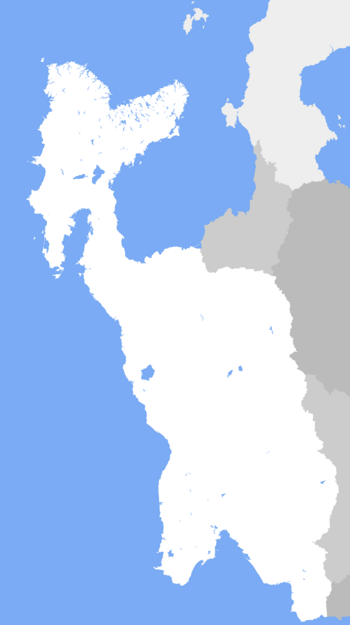Kiyortza
United States of Kiyortza Kiyortzani Linsori Vyarikin | |
|---|---|
|
Flag | |
 | |
| Capital | Kyrisje |
| Largest city | Loržika |
| Official languages | Kanesli Rijaki Ikari Norita Rukoči Žinasi Lorfier Ifarszi Astari |
| Ethnic groups | Several, TBA |
| Demonym(s) | Kiyortzani |
| Government | Democratic Federal Republic |
• President | Jaro Ilhassn |
| Legislature | Parliament |
| Establishment | |
• TBA | April 5, 1769 |
| Area | |
• Total | 1,643,992 km2 (634,749 sq mi) |
| Population | |
• 2020 census | 194,416,610 |
• Density | 118.26/km2 (306.3/sq mi) |
| GDP (PPP) | estimate |
• Total | K$7.396 t ($9.763 t) |
• Per capita | $38,125 KJI ($50,325) |
| GDP (nominal) | 2019 estimate |
• Total | 6.477t KJI ($8.55t) |
• Per capita | 33,388 KJI ($44,072) |
| HDI (2020) | 0.911 very high |
| Currency | Kijorsi (KJI) |
| Time zone | UTC-8 |
| Calling code | +19 |
| Internet TLD | .kj |
Kiyortza (Kanesli: Kijorca), formally the Federal Republic of Kiyortza, is a country in northwestern Thuadia, nestled largely between the Paisi Ocean to its west and Vaali Mountains to its east, with a handful of island possessions, including most prominently the island of Žinat and the islands of Irkylis and Nikorva. Covering an area of just over 1.6 million square kilometers*, it shares a land border with the nations of Astariax, Askye, Vescarium, and Fichmanistan, all to its east, while all of its remaining bounrdaries are dictated by sea.
Southern Kiyortza, alongside regions of nearby Vescarium, is thought to be one of the early cradles of civilization, tracing much of its history back six to seven millenia alongside the Tanes and Rijaga Rivers, abundant sources of water in an otherwise dry and fairly unwelcoming landscape of desert and chaparral. For several millenia, the civilzations of southern Kiyortza were the dominant power west of the Vaalis, though with the emergence of civilzations further north within the Itikov and Alf Basins, the region soon became divided between north and south, separated primarily by the Fukulji Mountains. As such, until more recently, the states within Kiyortza had been undergoing a perpetual cycle of expansion, conquest, and fracturing.
By the 16th century, the borders that would define modern Kiyortza's internal and externals borders had mostly taken shape, between the Ikari conquests of Astari land, Rijaki conquest of the Ifarszi plateau, and the creation of Kanesli Akesda; by the early 17th century, the nation of Kiyortza was formed through personal union between the Kanesli and Viškari crowns, bringing a brief period of prosperity. By the mid-18th century, however, the growing authoritarianism of leadership and general economic decline soon brought widespread discontent, and led to eventual revolution.
WIP
